|
|
Advertisement:
|
|
Xice ExternalCool Watercooling Kit |
|
Join the community - in the OCAU Forums!
|
The xpk waterblock, Installation
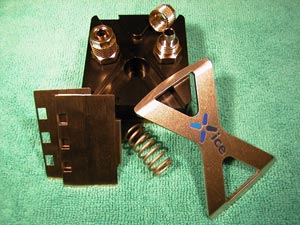
The xpk kit has 5 components: the waterblock itself with integrated metal hose barbs, a signature X-shaped top retention bracket, two side clips and a spring to provide downward force to keep the block in place. The top part of the water block is black anodized aluminium casing, while the base is made from copper. Xice say that the block is "Equipped with a solid CNC outline-milled copper block and the integrated C3 cooling technology (counter current cooling) ", which - other than the marketing techno-babble - means its all cut from a single solid piece of metal, which is usually a good thing as the heat spreads though the block better.
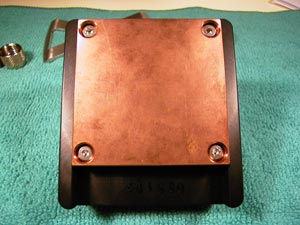
As you can see in the picture above, the base of our xpk was not finished very well and showed noticeable machining marks. While we resolved to test the kit as it was supplied to us, the base of the waterblock was a definite candidate for lapping. Xice also advertise two 'limited edition' Silver (copper with shiny nickel plating), or Gold (copper with shiny gold plating) waterblocks. These are available in your kit for an additional 5,00 EUR or 10,00 EUR respectively. Given the finish on our copper block, I expect they would be a worthwhile investment.
In the picture above you will also note that the heads of the screws used to attach the base of the block are badly stripped. I'm not sure if this is a usual occurrence when Xice assemble the waterblock or if it was a deliberate attempt to stop us from disassembling the unit. Unfortunately the screws were so damaged we were not able to undo them to photograph the interior of the xpk. This will also make opening the unit difficult if cleaning is required. Internally the Xice block apparently has a single maze-type channel with the water inlet on the left, and the outlet on the right (when viewed from the top end of the block, where the thermal probe hole is located).
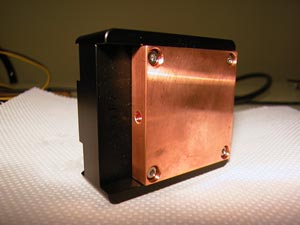
The base of the waterblock also has a small hole which allows for the use of an external thermal probe. However I expect this feature is next to useless, as when the xpk is installed the side clips completely cover the sides of the block (see pictures below) so there would be no way to position the thermal probe or route the wires. Perhaps Xice sell a specifically designed probe, but I could not find one on their website.
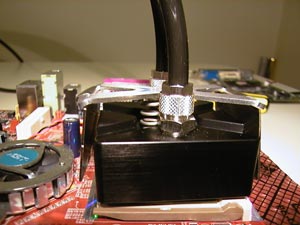
The xpk positioned ready to be installed.
While each of the xpk’s components is solid, well engineered, and look quite good, I felt that the design of the retention mechanism left a lot to be desired. In theory it works something like this: put the spring in the hole on the top of the waterblock, slot the X-shaped retention bracket into the channels on the top of the block, slip the side clips into place and then push down to compress the spring and slot the clips into place on the CPU bracket lugs.
The first major problem is that it's difficult to install by yourself. Pressing down on the clip requires the use of one hand, and then it's tricky to connect each of the side clips into place. Often the side clips were not correctly aligned with the CPU socket mounting lugs, and there was a real temptation to rotate the unit to position them correctly. However, if this was done while pushing down heavily on the top of the waterblock, I could imagine this could easily grind the edges off the CPU core.
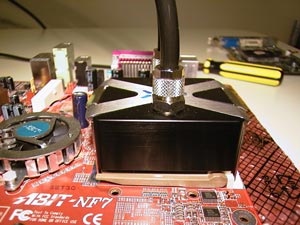
The xpk installed.
The next major concern I had was the amount of force required to compress the spring. Using a set of digital scales, I made a very rough measure and found that it required about 6.5kg of force to compress the spring. Given the exposed and notoriously fragile nature of AMD CPU cores, I could easily imagine the process of installing the xpk resulting in damage to the CPU.
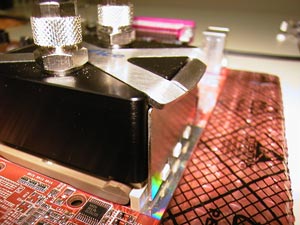
The side clips holding the xpk in place.
Additionally - and especially if attempting to install the xpk by yourself - after slotting one side clip into place, attempting to maintain even pressure on the spring via the retention bracket and then manoeuvre the other side clip into place is not easy. This could very easily result in tilting the base of the waterblock and applying a large amount of force to only one edge of the CPU core, which would more than likely damage it.
Personally I feel that the xpk's retention mechanism has been designed more to look good rather than to perform well and safely. The Xice waterblock is certainly not something I would want to install and remove very many times, and each time much care is required.
|
|
Advertisement:
All original content copyright James Rolfe.
All rights reserved. No reproduction allowed without written permission.
Interested in advertising on OCAU? Contact us for info.
|

|


